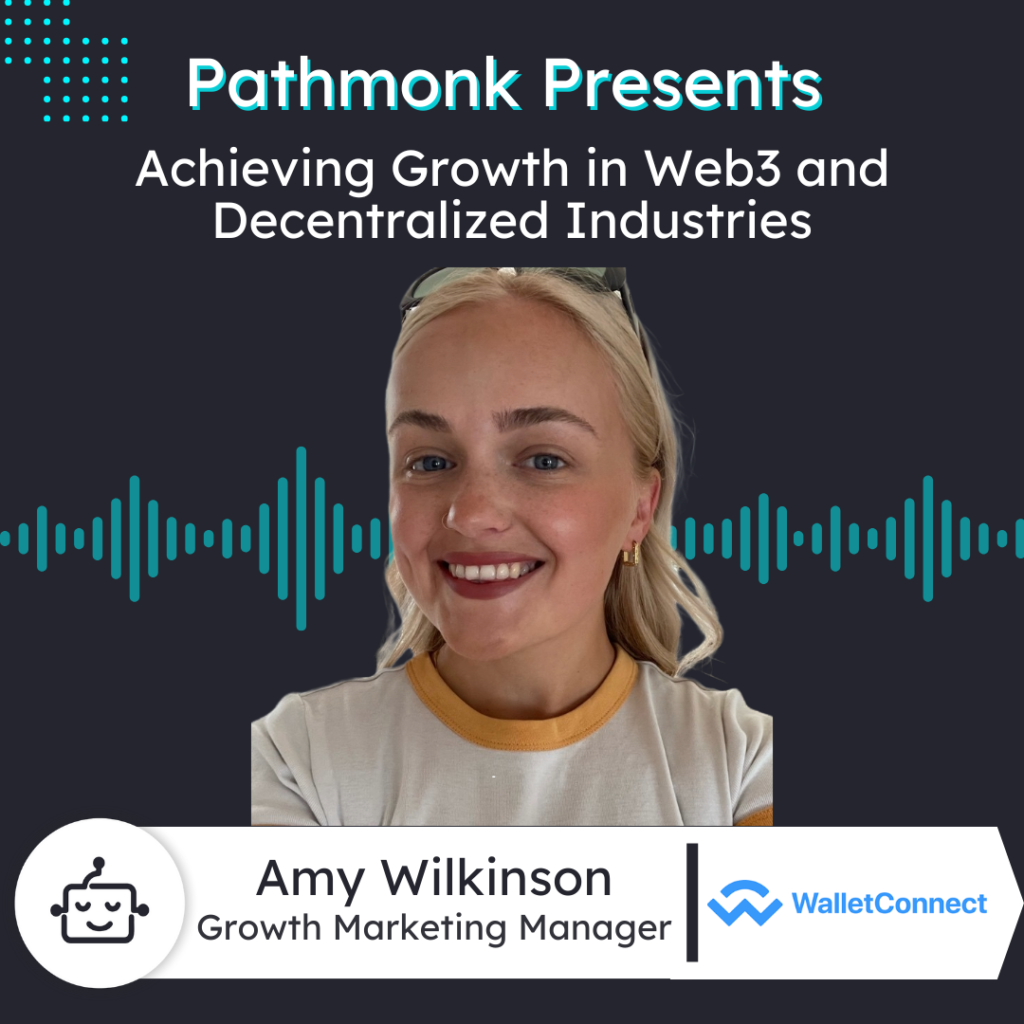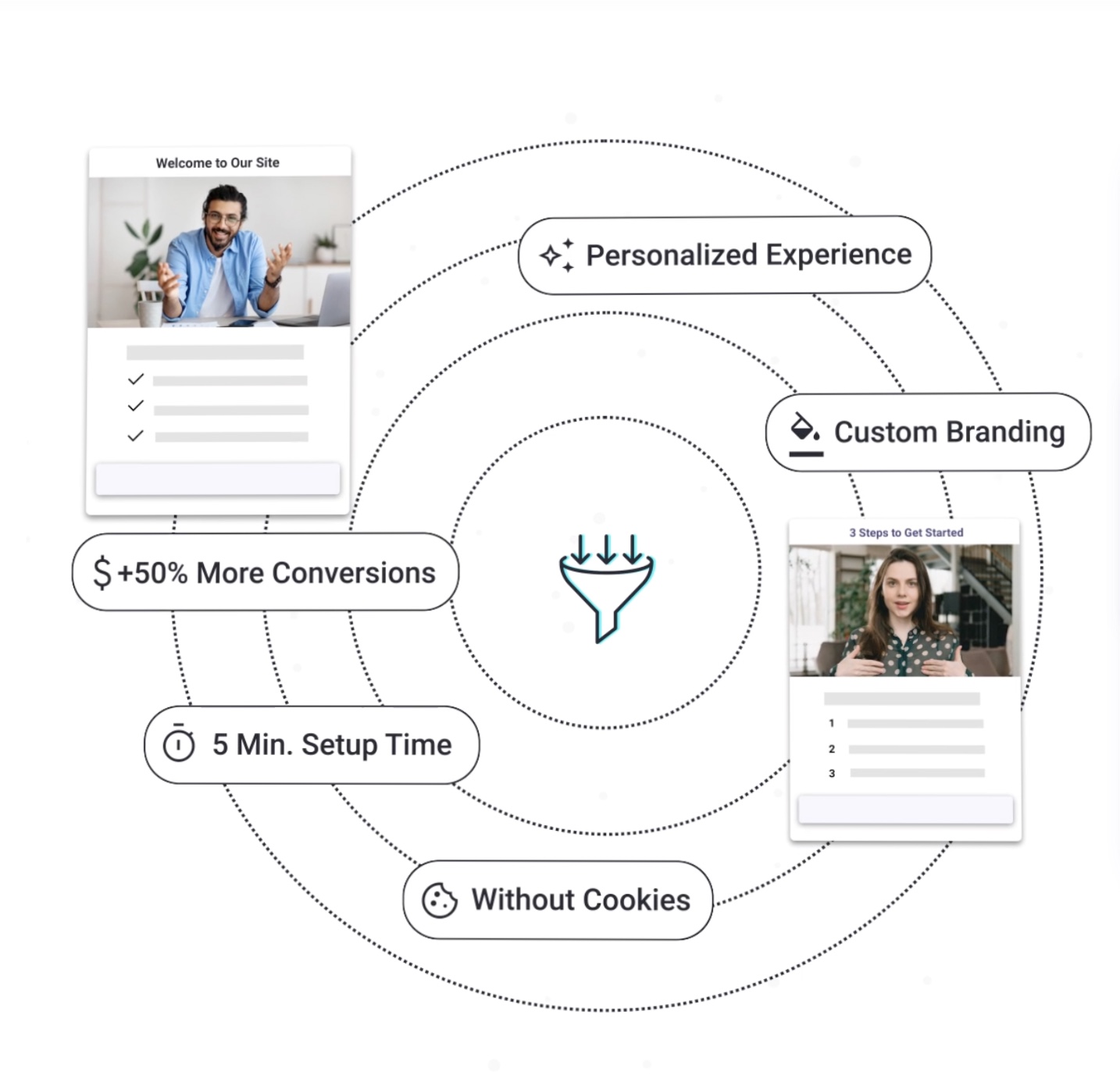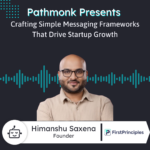
Introduction
In this episode, we welcome Amy Wilkinson, Growth Marketing Manager at Wallet Connect.
Amy delves into the world of decentralized internet and how Wallet Connect is revolutionizing user experiences in this space. She explains their messaging protocol and developer tools that enable seamless, secure, and scalable interactions in the Web3 ecosystem. Amy also shares insights on marketing strategies in the fast-paced Web3 industry, emphasizing the importance of organic growth, events, and Web3-native tools.
The conversation covers challenges in building user-friendly experiences, the role of websites in client acquisition, and Amy’s approach to leadership and staying updated in the marketing world.
More Sales From Your Website With AI
Personalized interactions based on your users' behaviour to get +50% more conversions.

Ernesto Quezada: Pathmonk is the intelligent tool for website lead generation. With increasing online competition, over 98% of website visitors don’t convert. The ability to successfully show your value proposition and support visitors in their buying journey separates you from the competition online. Pathmonk qualifies and converts leads on your website by figuring out where they are in the buying journey and influencing them in key decision moments. With relevant micro-experiences like case studies, intro videos, and much more, stay relevant to your visitors and increase conversions by 50%. Add Pathmonk to your website in seconds. Let the AI do all the work and get access to 50% more qualified leads while you keep doing marketing and sales as usual. Check us on pathmonk.com. Welcome to today’s episode. Let’s talk about today’s guest. We have Amy from Wallet Connect, growth marketing manager with them. How are you doing today, Amy?
Amy Wilkinson: I’m great, thanks. Really excited to be on the show and chat all things marketing.
Ernesto: Definitely. And, well, I’m excited as well to learn a little bit more about what Wallet Connect is all about. And, well, I’m sure our listeners are tuning in wondering that as well. So, Amy, let’s kick it off with that. In your own words, can you tell us a little bit more?
Amy: Absolutely. So we’re in web three. We are kind of pivotal in a very young industry. We’ve been around for a considerable amount of time. If you don’t know web three, it’s kind of a new frontier for the internet. The terminology web three comes from the internet that we have that exists today, considered as web two. Web three is a decentralized form of the internet. So it’s being pegged as the future version of the internet, which gives people back control over their own position in their online digital identity. What Wallet Connect does is a couple of things. We have a messaging protocol that enables products and anyone building anything on this new frontier of the internet to actually connect with other applications, connect with customers, connect with customers’ accounts, and users. At the same time, we also build developer tooling, which lets the same kind of customer base—anyone building in this new frontier of the internet—build a plethora of tools, essentially build a great user experience for their customers who come into web three and can actually experience a traditional web two-like experience that they’re used to when they’re surfing the internet. So, more secure, seamless, scalable, and just an all-around nicer kind of user experience for people exploring crypto and decentralized internet.
Ernesto: Definitely. Okay, awesome. So that way our listeners could get a good understanding of Wallet Connect. Amy, what would you say is the key problem that you guys like to solve for clients?
Amy: Yeah, so web three is young. Web three is an industry that’s been around for less than 20 years. So it’s a really, really young industry. It has a lot of promise, a lot of hope. It has a great concept and great values for the future of the internet and many other industries that it touches. The difficulty that a lot of people building in this space have today, who are very value-aligned with what this new internet can provide and offer, is that it’s really difficult to build in. If anyone listening has ever worked for a decentralized project, taking away the central protocols and central products that we’re used to working with—like Meta and Amazon, which we typically use day in, day out as developers, businesses, and customers— in the format of the internet that we have today, we don’t have that, which really removes some of the communication opportunities. A lot of the user experience is very limited when you enter into web three. So any builders—and we’re a B2B service—any builders developing in this industry today are often met with a lot of difficulties in building nice user experiences, which then leads to difficulties onboarding users. When users have a really terrible experience, they’re going to tip back into what they’re used to and not want to use your product. So the problem that we’re solving for a lot of our customers today is really improving that user journey, again across security, just general UI and UX. We are building a series of tools that developers and businesses can use to really improve that user journey and ultimately grow and scale their product and community.
Ernesto: Definitely important. All right, awesome. So then how would somebody usually find out about Wallet Connect? Is there a top client acquisition channel for you guys, Amy?
Amy: It’s funny, there’s a few. Obviously, we’re a digital-first industry, a digital-first product. The interesting thing about web three is that it’s very value-oriented. The industry was built around the concept of a new internet, which typically, when we build a new solution, it’s because we’ve identified a problem, right? So the industry was built on the basis that there’s a problem requiring a solution, and it’s very value-aligned with everyone building in the ecosystem today. So a lot of those values orient around privacy, data, transparency. When it comes to web three, marketing and acquisition and lead gen are a whole new ballgame compared to traditional marketing. Where you’re looking at out-of-home and paid channels that traditionally work, it’s an entirely different ballgame in web three. There’s a lot of organic, there’s a lot of conferences and events. So IRL, which is interesting for a digital-native industry. And interestingly, as well, for anyone looking to get into the space, there are a lot of web three native tools as well, which as marketers we use a lot today. There are new web three socials. We have a very small industry and an even smaller customer base when we’re looking at B2B. There are tools like Forecaster and different social content tools within the industry. It’s a smaller audience, but you generally have a much higher threshold and reach among those audiences.
Ernesto: Interesting channels for you guys. And so that way our listeners who are tuned in could go out and visit you, Amy, they could always check you out at walletconnect.com. What role does the website play for client acquisition?
Amy: Yeah, I mean our website is critical to acquisition. As a B2B and as a company that provides products for those building software solutions, our product exists online, and it’s accessible through our website. Our website is part and parcel of all of our user journeys. We have an extensive requirement on documentation and education around what our product is, which all lives digitally on our website. Ultimately, without the website, we don’t have an evergreen single source of truth to host that information. It’s pivotal and critical to all of our user acquisition. We leverage it in different ways and optimize it in different ways, such as SEO tactics. Additionally, specifically, our CTAs across digital marketing generally lead back to our website. So it plays a really critical role, which is quite standard in today’s world for SaaS and software.
Ernesto: Definitely. I agree with that. So then on that note, Amy, is there any tools or tips or methods that you would recommend to our listeners as far as website lead generation?
Amy: Absolutely. I think: test, test. I am a big fan of testing everything across the website, landing pages. A lot of things are based on how big your team is and what resources you have. But the more you can test messaging, positioning of buttons, CTAs on websites, user journey, and drop-off points in the funnel—the better. Constantly be testing and analyzing data. Never make assumptions that the copy you’ve decided on is great just because you’ve done a bit of SEO long-tail research. You can have the greatest ideas, but sometimes, when you’re analyzing data and testing, you discover that the unexpected option performs the best. You find some great low-hanging fruit there. So test, analyze your data, and don’t underestimate the power of possibly being wrong and finding some great opportunities through that.
Ernesto: Love what you said, right? Don’t underestimate. You’re going to be wrong sometimes, but that’s what testing is all about so you get the right formula. Awesome to hear that from you, Amy. Thank you so much for sharing that with us and for our listeners as well. And, well, let’s switch gears a little bit here, Amy, and talk about you as a leader. What are some key tasks you like to focus on in your day-to-day work?
Amy: I’m lucky to have a really great team. We have a very high level of execution at Wallet Connect. Being a very young industry, it’s also a very fast-paced and evolving one. If we are not constantly shipping, keeping on top of industry changes, and staying agile, we’re behind. I have a really great team that works operationally in execution. One thing that I do a lot of, specifically at Wallet Connect but also generally from my five-plus years in the industry, is focusing on strategy and supporting vision and brand to ensure it’s an integral part of what we’re doing. In web three, if there are any listeners working in the industry, you know that being an engineering, developer, and tech-native industry, we’ve evolved a lot over the past decade. We’ve moved from marketing only within small like-minded cohorts to scaling and growing as an industry, onboarding people from more traditional realms and wider markets. Many brands have gotten by without fully understanding their brand positioning, tone of voice, vision, mission, or purpose. At Wallet Connect, we have a pretty solid grasp on this and know what we are working towards. My recent focus, especially over the last two years, has been on strategy, prioritization, and making sure that as opportunities come up, we leverage and focus on those that align with our north star strategy, particularly as the industry continues to grow.
Ernesto: I mean, you say you’re lucky, but you’re the leader there, so you’ve built that environment. Kudos to you for making that happen. In between times, Amy, how do you stay up to date with all the news, trends, and strategies out there in the marketing world? Is there a preferred channel you like to go with?
Amy: I do love podcasts. My preferred channel fits my kind of hacky brain and allows me to dip in and out of things as I have time. I am also a big fan of newsletters—I like the Marketing Brew, for example. There are a few KOLs I enjoy following and listening to, like Neil Patel. Written content is my favorite form, but specifically within my industry, I make sure to refine my social feeds and echo chamber to only the most valuable information. This allows me to dip into those channels and get useful information whenever I have a window of opportunity to expand my thinking and stay up to date.
Ernesto: All right, great. Those are channels for our listeners as well. Amy, let’s jump into our next section, which is our rapid-fire question round. Are you ready?
Amy: I am.
Ernesto: Perfect. First off then, Amy, what is the last book you read?
Amy: The last book I read was “Read Write Own” by Chris Dixon—very web three.
Ernesto: Okay, perfect. A great read for listeners in the web three area. Next up then is: if there were no boundaries in technology, what would be one thing you’d like to fix for your role as a marketer today?
Amy: Probably something around AI—a really simplified tool. The groundwork is there for us to leverage AI in a great way, but today, it takes significant internal resources to build out the model required to have a one-tap experience for repurposing all your content for multiple platforms. It would be great to have a really solid tool just available at hand for that.
Ernesto: Perfect, awesome. Now, if there’s one repetitive task that you could automate, Amy, what would it be?
Amy: Email checking. No, I’m kidding. Probably content repurposing, which I think we’re making progress on, but we’re still a little way off. There is definitely room to optimize repurposing content.
Ernesto: Yep, I think we all can agree with that. Also, email checking—it’s definitely very important! Lastly, Amy, you have a lot of experience already in the marketing world, but what is one piece of advice you would give yourself if you were to restart your journey as a marketer today?
Amy: Outcomes over outputs, aligned with prioritization—something you learn along the way. I would love to go back years and understand the value and ROI of the time I was putting into things. For a lot of people starting in the industry, especially with smaller projects, the go-to is to write a blog for everything, but there’s not always a huge outcome from that. Understanding prioritization and outcomes over outputs is key. It took me a few years to get that ingrained.
Ernesto: Thank you so much for sharing that—hopefully, our listeners can take that to heart right now. Amy, we are coming to the end of our show today, but before we wrap up, I want to give you the last word. If someone forgets everything from this interview, what’s the one thing they should remember about Wallet Connect?
Amy: The new internet is an exciting opportunity for many industries and projects. The concept of the new internet and technologies being built today for the digital landscape is amazing. We work directly with projects and companies looking to build in this space. For anyone aware of web three and decentralization but not sure where to start, or already building and looking for simplified tools to succeed, connect with us. Check out our website, and we’re always here to help you build in web three.
Ernesto: You guys heard it. Check them out at walletconnect.com—build engaging web three experiences. Amy, thank you so much for being on with us today, and to our listeners, thank you for tuning in. I’m looking forward to our next episode at Pathmonk Presents. Thanks a lot, Amy.
Amy: Thanks for having me.











